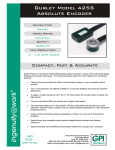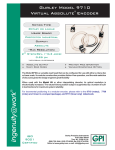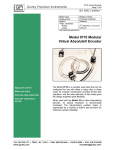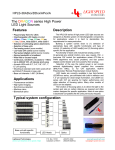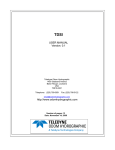Download ingenuity@work - Gurley Precision Instruments
Transcript
Gurley Model V860H â Virtual Absolute Encoder Motion Type: Rotary Usage Grade: Metrology/Industrial Output: Absolute Max Resolution*: 2 20 (1,048,576) steps/rev ingenuity@work Ò Natural Binary Absolute Output The V860H is a high-performance optical encoder that utilizes unique Virtual Absolute technology to combine the opto-mechanical simplicity and ruggedness of an incremental encoder with the system reliability and interfacing ease of an absolute encoder. This encoder has been designed for quasi-military applications such as radar pedestals and tracking mounts. * Custom resolutions available up to 24 bits. Please contact factory for more information ISO 9001 Certified Gurley Precision Instruments 514 Fulton Street Troy, NY 12180 U.S.A. (800) 759-1844, (518) 272-6300, fax (518) 274-0336, Online at www.gurley.com, e-mail: [email protected] GPI IIIIIIIIIIIIII SPECIFICATIONS 20 *Resolution 2 (1,048,576) words/rev ** Installed Accuracy ±1.5 arcs, including quantization & coupling errors Initialization angle 0.308° Output code Parallel natural binary Output device TTL-compatible tri-state buffer registers Max. data update rate 1 MHz Parity Odd Shaft direction for increasing count Clockwise, looking at bellows end Input power +12Vdc ±0.5V @375 mA max Illumination source LEDs, screened and derated for 100,000-hr life Max. operating speed 120°/s Operating temperature, °F (°C) -40 to +185 (-40 to +85) Storage temperature, °F (°C) -58 to 212 (-50 to + 100) Humidty 98% rh, non-condensing Weight, encoder + coupling lb (kg) 12 lb (5.5) ** Starting torque, in-oz (N-m) 16 (0.11) ** Running torque, in-oz (N-m) 12 (0.08) 2 3 Moment of inertia, in-oz-s (g-cm) 0.27 (19 x 10 ) Sealing IP64 * Custom resolutions available up to 24 bits. Please contact factory for more information. ** At 20°C As part of our continuing product improvement program, all specifications are subject to change without notice. V860H Page 2 of 8 V3.1 Gurley Precision Instruments 514 Fulton Street Troy, NY 12180 U.S.A. (800) 759-1844, (518) 272-6300, fax (518) 274-0336, Online at www.gurley.com, e-mail: [email protected] GPI IIIIIIIIIIIIII Theory of Operation A Gurley Virtual Absolute (VA) encoder employs an optical encoding technique which is still relatively new to the motion control industry. Like an incremental encoder, the VA optical disc uses only incremental and index code tracks. The incremental track is structured and read by quadrature sensors in the usual way. However, neither the encoder nor the host system accumulate incremental counts as the read station traverses. Instead, the four quadrature states per optical cycle are decoded to control the spatial timing of indexing operations, whereby the absolute position information is obtained. The index track is coded differently from a conventional incremental encoder. On the index track, an opaque or transparent region exactly one optical cycle wide aligns correspondingly with every opaque/transparent line pair in the adjacent incremental track. Around the full circumference of the disc, any given index mark is equally likely to be clear or opaque. The bit sequence into which the index marks will be translated by the detector dedicated to this track is pseudorandom. Absolute position is encoded serially in this one track rather than in parallel over many tracks. This simplifies optomechanical alignment compared with traditional absolute encoders. A 14-bit VA employs a sequence of 16384 indices. These are decoded for cycle position, to which 6 bits of interpolated position within the cycle are appended. Every possible grouping of 14 consecutive indices in the sequence is unique due to the non-repeating design of the code. Every optical cycle of the incremental timing track is thus tagged by a unique 14-bit code whose first bit is immediately adjacent to the cycle, and whose remaining 13 bits trail behind. This arrangement is sometimes called a chain code. Because the coding sequence is such that each 14-bit code tag shares 13 bits with its neighboring tags to the left and right, in overlapping fashion, one might conclude that the code progression is monostrophic (like Gray code) with only one bit differing between consecutive tags. Not so. While adjacent tags share all but one bit, the positions of all the shared bits within the tags are shifted. Tags which truly differ by only one bit are located in seemingly random sections of the scale. Improperly decoded tags would therefore result in gross position errors. Partly for this reason, a sophisticated sequence verification capability is an integral part of GPI's proprietary Virtual Absolute tag decoder design. On power-up, absolute position is unknown. An initialization procedure is executed to obtain a complete tag for decoding. (There are ways to build a pseudorandom encoder so that absolute information is available on power-up without initializing, but these techniques require far more complex sensing hardware; they often impose slower operation as well. And none of them offers the sophisticated built-in testing of GPI's Virtual Absolute technology.) Because the index track is viewed by a single sensor the read station must be bumped in either direction, or wiggled in both, to cover a minimum net angle. In this case, a net motion infinitesimally less than 14 optical cycles guarantees 14 major cycle boundaries of the incremental timing track will be crossed. This corresponds to 0.308 maximum initialization traverse from any starting position of the disc. Discs with higher line counts require shorter initialization traverses, but are correspondingly more difficult to install and align. Cycle boundary phasing with respect to the index marks is such that indices are sampled only at their centers, i.e., spatially timed. For this reason, the incremental track is sometimes called the timing track. This arrangement has two important benefits: ! As with conventional incremental encoders, the readout accuracy (linearity) of the VA encoder depends only on the regularity of its incremental track lines. These are easy to create on the disc with precision, and easy for the quadrature detectors to read accurately through slit gratings that average out microscopic optical printing imperfections and moderate amounts of contamination. This also results in healthier signal amplitudes. Conventional absolute encoders have difficulty employing a similar optical averaging technique to improve readout accuracy and signal-to-noise ratio. ! The serial indices, which must be viewed through a single mask aperture like a conventional absolute, rather than through a grating, are at their maximal light or dark conditions when sampled. This ensures the greatest electrical noise margin, immunity to contamination, and tolerance of misalignment between disc and read station. Unlike a conventional absolute encoder, the exact angular position of the transition between light and dark has no effect on decoding reliability or accuracy. V860H Page 3 of 8 V3.1 Gurley Precision Instruments 514 Fulton Street Troy, NY 12180 U.S.A. (800) 759-1844, (518) 272-6300, fax (518) 274-0336, Online at www.gurley.com, e-mail: [email protected] GPI IIIIIIIIIIIIII Theory of Operation Once the first tag has been obtained from the disc, bit-wise, during the initialization traverse, ensuing motions modify the tag based on direction of motion. (Direction sense is always available from the quadrature incremental track waveforms.) As new tags become available, they are decoded into monotonic natural-binary absolute position words. During the tag decoding process, an exor gate compares each new detected bit obtained from the index track against the bit the tag decoder predicts for that direction of motion. In effect, the decoder knows the entire serial code sequence and reports any disagreement between expected and detected tag bits as a fault condition. In this way, the encoder's design embodies a sophisticated real-time automatic error detection technique that is constantly on guard against malfunction with every motion of the disc. This capability is equivalent to the most fully refined monotonicity test system possible in a conventional absolute encoder, yet imposes no appreciable overhead in hardware because it is a natural byproduct of GPI's patented tag decoding method. A GPI Virtual Absolute encoder system can be in any one of 3 distinct operating modes: ! Wait mode: It may be aware of an interruption of power, or some other interference to normal operation which it interpreted as an invalid tag. Until a (re)initialization traverse has been executed to refresh the code tag in the decoder, the VA reports a fault condition while it is waiting for a full tag to be acquired. ! Search mode: Having acquired a complete new tag from an initialization sweep, it may be busy pinpointing the absolute position of the new tag in the overall code sequence. How long this tag search will take depends on specific design characteristics of the decoder, including its 16-MHz clock speed. It also depends on how far away the read station happens to be from the starting point of the search, and whether the decoder is chasing the axis position from behind as it also moves during the search. In the worst case scenario, a 14 bit tag search will take about 4 mS. ! Track mode: It may be decoding all new indexing code tags obtained from the read station satisfactorily, validating the code bit-wise as it's detected, and providing reliable absolute position information, i.e., tracking the motion input in servo fashion. If scale contamination or overwhelming electrical noise should invalidate the index signal or even the proper operation of the decoder itself, this will result in a reported fault: ! Proper quadrature sequence is verified at all times. Since this could corrupt the tag bit due to improper sample timing, the decoder resets and awaits a fresh tag. ! Successors to a false tag will survive very little following motion of the disc before faulting due to the non-repeating nature of the code sequence. ! A supply voltage supervisor and power-up reset IC is included to reset the decoder if the power supply dips below +4.70VDC measured locally inside the encoder. Most fault conditions may be cleared by re-executing the initialization procedure. In the case of disc damage or fouling, the host system may measure the affected region by approaching it from alternate directions and observing the Status bit reporting the validity of the absolute position output. The Status bit offers a simple mechanism for a microprocessor-based host system to quickly assess data validity. If the tag decoder detects a fault condition and is waiting for an initial tag sweep or while it is still engaged in a tag search, the Status bit will be set to a logic 1, signifying the current output value is invalid and position is unknown. For a more thorough discussion, see the V860H User's Manual. V860H Page 4 of 8 V3.1 Gurley Precision Instruments 514 Fulton Street Troy, NY 12180 U.S.A. (800) 759-1844, (518) 272-6300, fax (518) 274-0336, Online at www.gurley.com, e-mail: [email protected] GPI IIIIIIIIIIIIII SPECIFICATIONS READOUT TIMING REQUIREMENTS The read cycle is initiated by bringing the Interrogate line low. The data will be valid 750nS after the falling edge of INT. Synchronicity of all data transitions cannot be guaranteed in any device with natural binary output. The output buffer register is provided to avoid reading out a mixture of old and new data bits when sampling the output at the exact moment position data is changing. SHAFT COUPLING The optional precision flexible metal bellows assembly P/N DX00432 compensates for small angular misalignment, axial extension or compression, or parallel offset in the installation, without affecting bearing or bellows life. Keeping the misalignments within the following constraints will assure infinite life of the coupling, but will introduce some error. To preserve the encoder's accuracy, misalignments should be kept as small as possible. 83.3P + 3E + 0.14A < 1.0 P = Parallel offset, inches (max = 0.012") E = Axial extension or compression, inches (max = 0.336") A = Angular misalignment, degrees (max = 7) Parallel offset, P, is equal to the total offset between the centerline of the encoder and the centerline of the user's shaft, plus half the radial runout (TIR/2) of the user's shaft. Table 1 - Power Pin Connections, DA-15P Pin 1 2 3 4 5 6 7 8 9 10 11 12 13 14 15 Name GND GND Type Power Power Description Ground, power supply common Ground, power supply common GND GND +12 Power Power Power Ground, power supply common Ground, power supply common Single +12VDC supply, regulated to +5VDC internally GND Power Ground, power supply common GND +12 +12 Power Power Power Ground, power supply common Single +12VDC supply, regulated to +5VDC internally Single +12VDC supply, regulated to +5VDC internally V860H Page 5 of 8 V3.1 ELECTRICAL CONNECTIONS If the V860H is ordered with connector code P, the three cables are terminated in pigtails; the wire colors are shown on the dimension drawing on page 8. If it is ordered with connector code D, the cables are terminated in two connectors: a DA-15P, which contains all the power leads, and a DC-37P, with all the data. Connector code D interfaces with any cable harness designed for Gurley's discontinued model 60/25H conventional absolute encoder, which had an external electronics package. Since the V860H does not have a separate electronics package, the cable and connectors coming from the encoder are wired and polarized to imitate the previous electronic package connectors. Blanks in the pinout tables below signify pins which are not connected to anything inside the encoder. The power interface connector mates with a standard DA-15S D-subminiature connector with spring latches. Gurley Precision Instruments 514 Fulton Street Troy, NY 12180 U.S.A. (800) 759-1844, (518) 272-6300, fax (518) 274-0336, Online at www.gurley.com, e-mail: [email protected] GPI IIIIIIIIIIIIII SPECIFICATIONS Table 2 - Data Pin Connections, DC-37P Pin 1 2 3 4 5 6 7 8 9 10 11 12 13 14 15 16 17 18 19 20 21 22 23 24 25 26 27 28 29 30 31 32 33 34 35 36 37 Name PAR D01 D03 D05 D07 D09 D11 D13 D15 D17 D19 STA Type Output Output Output Output Output Output Output Output Output Output Output Output Description Parity, odd parity scheme Data bit Data bit Data bit Data bit Data bit Data bit Data bit Data bit Data bit Data bit, LSB weighted 1/1048576 revolution Status, 1 = current data invalid, 0 = current data valid TRU Input True, cancel any position offset in effect GND Power Ground, power supply common D00 D02 D04 D06 D08 D10 D12 D14 D16 D18 CLR FLT Output Output Output Output Output Output Output Output Output Output Input Output Data bit, MSB weighted 1/2 revolution Data bit Data bit Data bit Data bit Data bit Data bit Data bit Data bit Data bit Clear, falling edge clears fault flip flop Fault, 1 = chain code or quadrature error detected & stored OFF INT Input Input Offset, make current position equal zero Interrogate, copy current position to output buffer register GND Power Ground, power supply common The data I/O interface connector mates with a standard DC-37S D-subminiature connector with spring latches. V860H Page 6 of 8 V3.1 Gurley Precision Instruments 514 Fulton Street Troy, NY 12180 U.S.A. (800) 759-1844, (518) 272-6300, fax (518) 274-0336, Online at www.gurley.com, e-mail: [email protected] GPI IIIIIIIIIIIIII Coupling Details V860H Page 7 of 8 V3.1 Gurley Precision Instruments 514 Fulton Street Troy, NY 12180 U.S.A. (800) 759-1844, (518) 272-6300, fax (518) 274-0336, Online at www.gurley.com, e-mail: [email protected] GPI IIIIIIIIIIIIII Ordering Information MODEL RES FORMAT INT BASE P 06 A V860H 16384 RES 16384 CAB EXIT CONN T P Parallel natural binary output INT 06 6 bits of internal interpolation BASE A Standard base & mounting configuration CAB XX 48 EXIT T Top-exit cable CONN P D Pigtails DA-15P (power) + DC-37P (data) 40E TEMP 40E A SPEC Disc resolution, lines FORMAT DIA DIA Cable length, inches 48 inches standard 2.5-in dia through-hole shaft TEMP A -40°C to +85°C operating temperature range SPEC # N Issued at time of order to cover special customer requirements No special features ACCESSORIES (order separately) DX00432 Bellows-type shaft coupling SPECIAL CAPABILITIES For special situations, we can optimize catalog encoders to provide higher frequency response, greater accuracy, wider temperature range, reduced torque, non-standard line counts, or other modified characteristics. In addition, we regularly design and manufacture custom encoders for user-specific requirements. These range from high-volume, low-cost, limitedperformance commercial applications to encoders for military, aerospace and similar high-performance, high-reliability conditions. We would welcome the opportunity to help you with your encoder needs. WARRANTY Gurley Precision Instruments offers a limited warranty against defects in material and workmanship for a period of one year from the date of shipment. V860H Page 8 of 8 V3.1 Gurley Precision Instruments 514 Fulton Street Troy, NY 12180 U.S.A. (800) 759-1844, (518) 272-6300, fax (518) 274-0336, Online at www.gurley.com, e-mail: [email protected] GPI IIIIIIIIIIIIII








